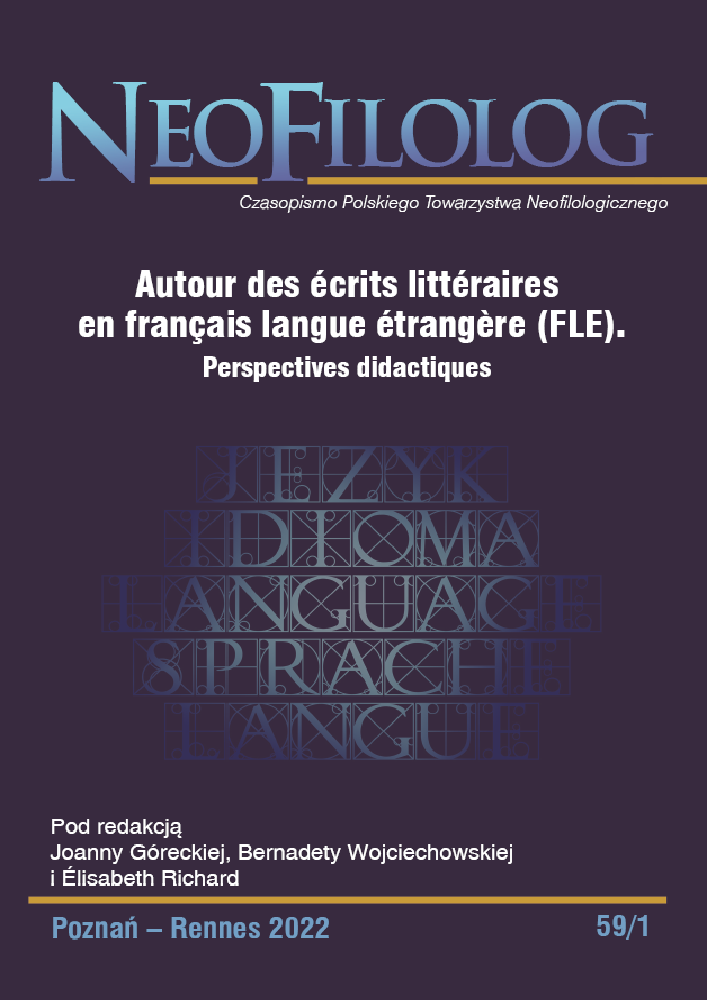Résumé
Current research on interculturality in foreign language teaching focuses on the development of the intercultural personality of the learner based on his social representations. In this context, the introduction of crime fiction in French foreign language teaching makes it possible to take the complexity of the human personality more efficiently into account when developing the intercultural competence of the learner. Based on a thematic analysis of the novel Derrière les panneaux il y a des hommes (Behind the Panels There Are Men) by Joseph Incardona, which aims at highlighting the references to French culture in the text, and from a linear analysis centered on the characters and their complex personalities, the article proposes to apply the cultural and intercultural approaches of language didactics to literature. In this way, in order to develop cultural competence, the learners first learn to identify the cultural clues referring to French society in the text. Then, they learn to adopt a positive attitude of openness towards others through the characters of the novel to develop their intercultural competence.
Références
Aase L., Fleming M., Pieper I., Sâmihaian F. (2017), Les enseignements de la littérature pour une éducation plurilingue et interculturelle, (in :) Beacco J.-C., Coste D. (dir.), L'éducation plurilingue et interculturelle. La perspective du Conseil de l'Europe. Paris : Didier, 158-175.
Abdallah-Pretceille M., Porcher L. (1996), Éducation et communication interculturelle. Paris : PUF.
Amossy R., Herschberg Pierrot A. (2015), Stéréotypes et clichés. Paris : Armand Colin.
Bakešová V. (2020), La littérature, outil toujours actuel dans l'enseignement de FLE. « Romanistica Comeniana », n° 2, 63-76.
Beacco J.-C. (2018), L'altérité en classe de langue. Pour une méthodologie éducative. Paris : Didier.
Conseil de l'Europe (2001), Cadre européen commun de référence pour les langues : apprendre, enseigner, évaluer. Strasbourg : Didier.
Cuq J.-P. (2003), Dictionnaire de didactique du français langue étrangère et seconde. Paris : CLE international.
Debyser F. (1975), Lecture de civilisation, (in :) Beacco J.-C., Lieutau S. (dir.), Mœurs et mythes. Paris : Hachette/Larousse, 10-17.
Dufays J.-L. (1994), Stéréotype et littérature. L'inéluctable va-et-vient, (in :) Goulet A. (dir.), Le Stéréotype. Caen : Presse universitaire de Caen, 77-89. https://doi.org/10.4000/books.puc.9702
Galisson R. (1988), Cultures et lexicultures. Pour une approche dictionnairique de la culture partagée. « Annexes des Cahiers de linguistique hispanique médiévale », n° 7, 325-341. https://doi.org/10.3406/cehm.1988.2133
Hall E. T. (1976), Beyond Culture. New York : Anchor Books.
Incardona J. (2015), Derrière les panneaux il y a des hommes. Le Bouscat : Finitude.
Malinovská Z. (2020), Le roman noir de Joseph Incardona : un prétexte pour capter le présent, « World Literature Studies », n° 2, 4-13.
Moirand, S. (1979), Situations d'écrit. Compréhension, production en langue étrangère. Paris : CLE international.
Peytard, J. (1988), Des usages de la littérature en classe de langue, « Le Français dans le monde. Recherches et applications (numéro spécial, mars 1988) », 8-17.
Porcher L. (2004), L'enseignement des langues étrangères. Paris : Hachette.
Reichwalderová E. (2021), Urbánny priestor v súčasnej španielskej literatúre. J. J. Millás a jeho postmoderná vízia. « Development of Urban Culture. / Rozvoj urbánnej kultúry. Zborník z medzinárodnej vedeckej konferencie ». Banská Bystrica: DALI-BB, 252-263.
Tagliante C. (2006), La classe de langue. Paris : CLE international.
Zázrivcová M. (2021), Quand la force du roman noir repose sur sa langue, (in :) Jambor J., Souček J., Zázrivcová M. (dir.), Aktuálne spoločenské problémy v súčasnom kriminálnom románe na príklade textov z nemeckej, francúzskej a slovenskej jazykovej oblasti. Prešov: Filozofická fakulta, 209-229.
Licence
© Neofilolog 2022

Ce travail est disponible sous licence Creative Commons Attribution - Pas de Modification 4.0 International.
Auteurs :
Les auteurs de textes acceptés pour publication dans la revue Neofilolog sont tenus de remplir, signer et renvoyer à l'adresse de la rédaction, un accord sur l'octroi d'une licence gratuite pour les œuvres, avec obligation d'accorder une sous-licence CC.
En vertu de cet accord, les auteurs des textes publiés dans la revue Neofilolog accordent à l'Université Adam Mickiewicz de Poznań une licence non exclusive et gratuite et permettent l'utilisation de la sous-licence Creative Commons Attribution-NoDerivatives 4.0 International (CC BY-ND 4.0).
Les auteurs se réservent le droit de disposer librement de l'œuvre.
Utilisateurs :
Les utilisateurs d'Internet intéressés ont le droit d'utiliser les œuvres publiées à partir de l'année 2017 sous réserve des conditions suivantes :
- reconnaissance de la qualité d'auteur - l'obligation de fournir des informations sur la qualité d'auteur, le titre, la source (liens vers l'œuvre originale, DOI) et la licence, ainsi que l'œuvre distribuée ;
- sans créer d'œuvres dérivées - l'œuvre doit être conservée dans sa forme originale, p. ex. les traductions ou les interprétations ne peuvent être distribuées sans le consentement de l'auteur.
Tous les textes publiés sont soumis au droit d'auteur.
Autres :
L'Université Adam Mickiewicz de Poznań se réserve le droit à la revue dans son ensemble (mise en page, forme graphique, titre, conception de la couverture, logo, etc.).
.

